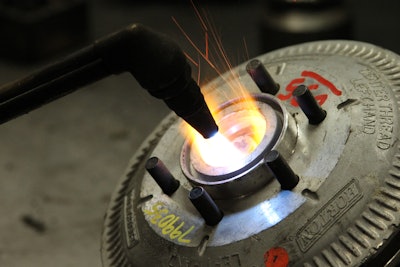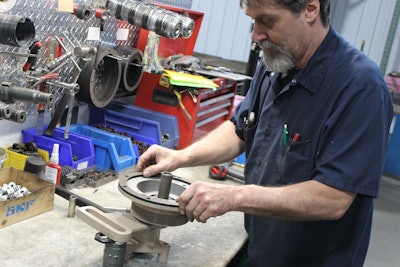
It’s fan clutch season.
Warmer temperatures are drawing more attention to the little part that keeps truck engines running efficiently. Fan clutches engage when coolant and the radiator can’t keep an engine’s temperature cool enough to run at its best, turning on a fan to cool the engine quickly.
[RELATED: Troubleshooter: Keeping cool: A systems approach]
“Fan clutches allow the engine fan to engage and disengage based on the truck’s cooling demand,” says Michelle Collins with BorgWarner. “To run the engine fan at full power requires up to 90 horsepower. Having the fan run at full power only when needed helps save fuel.”
When spring starts to heat up, that’s when many drivers notice their fan clutches aren’t working well or at all, and that’s when trucks end up down, says Kate Diecks, sales manager with Kit Masters.
“There’s only so many engagements before that friction material wears down or those bearings go bad,” then trucks sit overheated on the side of the highway, she says. “A lot of fleets will change the fan clutches at 400,000 miles or four years, because if your fan clutch goes bad, you’re stuck on the side of the road, and it’s a huge bill.”
BorgWarner makes on-off fan clutches and air-sensing viscous fan clutches. There are two configurations of on-off fan clutches, Collins says, the K32 and the DuroSpeed. Air-sensing viscous fan clutches come in three variations, the 750, 795 and 805. Each fan clutch is best suited to a different working environment.
“The DuroSpeed clutch is designed to run at a higher disengaged speed than the K32 clutch,” Collins says. “Running at a higher disengaged speed provides extra cooling to the engine and reduces the number of times the fan needs to run at full speed. The DuroSpeed clutch is ideal for more severe-duty applications, while the K32 is ideal for over-the-road applications.”
Some truck owners, Diecks says, make checking the thickness of the friction or the engagement of the fan clutch part of their preventive maintenance routine, replacing the part before it has a chance to go bad.
Collins says BorgWarner fan clutches have a liner that can be changed while the fan clutch is on the vehicle. She says the company makes a liner service kit as well as a service alert tool to check remaining fan clutch liner life.
BorgWarner also notes technicians check liner life by using a dime. Start with the fan clutch engaged – no air pressure to the drive – and place the dime against the cooling fins of the flux ring. If the dime slides against the outer edge of the lining retaining ring, then the line has remaining life. If the dime slides underneath the lining retaining ring, then the lining should be replaced.
In some cases, a control system issue caused by incomplete fan clutch disengagement due to low air pressure; slow fan clutch disengagement due to a low air flow rate caused by a contaminated air solenoid or a pinched airline, slow or incomplete fan clutch disengagement because of electrical issues; slow fan clutch engagement due to a plugged air vent, contaminated air solenoid or a pinched airline; and, lastly, due to frequent fan clutch and fan engagements lasting less than 30 seconds due to a lack of a fan on-time timer within the engine or vehicle control module, air conditioner problems or defective control system.
“Always check your air lines to make sure you have clean air lines for air-engaged fan clutches,” Diecks says. “It takes 90 PSI to hold the spring back to disengage the fan. You have to have enough air to hold the spring back.”
When swapping out a fan clutch, many OEM part numbers can be replaced by aftermarket options, like what’s sold by Kit Masters. Diecks says there’s good and bad things about being in the aftermarket. The bad part is the part doesn’t come on the truck, so parts people can’t look it up by VIN.

The good news is Kit Masters offers application guides to help technicians find the common failure points for many OEM fan clutches and give them a reference for the correct aftermarket part. Technicians also can take a picture of their fan clutch and upload it to Kit Masters and the company will find the replacement part.
The best news, though, is that aftermarket parts makers like Kit Masters can use those common failure points to improve on OEM parts, says Diecks
“Both [companies that make OEM fan clutches] make awesome products. If they didn’t, they wouldn’t be here,” she says. “But what Kit Masters does differently is that we see what they do wrong and we figure out solutions for that. We can’t make a me-too fan clutch. We have to be better.”










